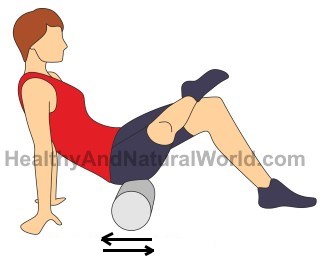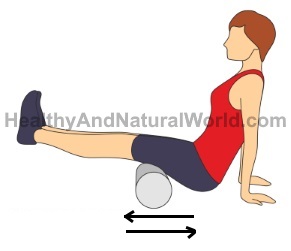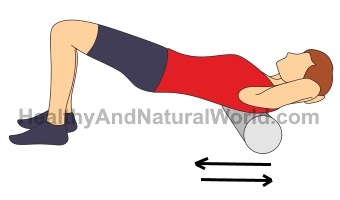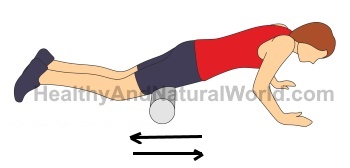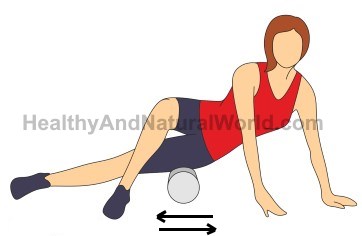Foam Roller Exercises for Sciatic and Back Pain
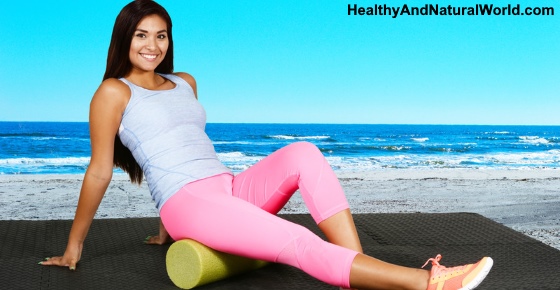
Foam roller exercises are a great way to massage your body to loosen up sore muscles and tight joints in an effort to aid muscle recovery. Foam roller exercises can also be helpful in preventing and treating back pain as well as sciatic nerve pain.
The sciatic nerve is the largest nerve in our body. It begins in the lower back and runs through the buttock and down the lower limb. Sciatic pain (sciatica) is caused by a compression or irritation of the sciatic nerve.
I’ve already mentioned how to use tennis ball to relieve sciatic pain and back pain, and shared with you stretches for sciatic nerve pain relief as well as yoga poses to soothe sciatic nerve pain.
In this article you will find out six specific exercises using a foam roller that can be helpful in treating sciatic nerve pain as well as back pain.
What Is a Foam Roller?
A foam roller looks like a log made of elastic foam and can be found at many sporting goods stores.
When the body lies on a foam roller, it pushes against the body and provides resistance. When you roll up and down on the foam roller, you experience a kind of pressure-facilitated massage. As a result foam rolling exercises are quickly becoming an alternative to expensive massage therapies.
The Health Benefits of Foam Rolling
Also called self myofascial release, foam roller exercises are a form of massaging that aids in muscle recovery, release muscle tightness or trigger points.
Here are a few of the health benefits of foam rolling:
Improved range of motion
Stretching has been used for years as the primary method for improving flexibility. A 2013 study published in the International Journal of Sports Physical Therapy stated that using a foam roller improved range of motion and muscle length performance. (1)
Reduced stress
According to a 2014 study published in the Journal of Physical Science Therapy, foam rolling was associated with lower levels of cortisol levels, otherwise known as the stress hormone. (2)
Read more about cortisol in my article about the 10 warning signs of high cortisol levels.
Reduced muscle soreness
There’s no need to try to wait out muscle soreness. A 2014 study published in the Journal of Medicine and Science in Sports and Exercise found that foam rolling prevented muscle soreness while also improving muscle activation, vertical jump height, and range of motion. (3)
Improved circulation
Proper circulation is important because the blood carries oxygen and other nutrients needed for proper health. Decreased blood flow can result in muscle numbness and impaired cognitive function. By massaging your muscles with a foam roller you can increase your blood circulation.
Injury prevention
Taking precautionary measures to prevent muscle tightness can help you stay healthy. Regular foam rolling and stretching help keep your muscles loose and prevent an overuse injury.
Foam Roller Exercises for Back Pain and Sciatic Pain
Pain in one area of the body may be caused by a condition or tightness that is located in a completely different part of your body.
According to The National Academy of Sports Medicine, it’s important to address all major muscle groups in the legs when dealing with sciatica or back pain.
Foam roller exercises can alleviate sciatica and back pain by loosening up the muscles that surround the area. Therefore, rolling the muscles that make up the hip flexors, the glutes, and the calves can reduce the amount of tension in the low back. (4)
Glutes (Piriformis Foam Roller Exercise)
The piriformis is a small muscle of the hip near the glutes. An inflamed piriformis muscle can be the cause of sciatica pain as the sciatic nerve runs below the piriformis muscle and in some cases it goes above or even through it. This exercise targets your glutes as well as your piriformis and it can relax them.
To roll out the glutes, sit on the floor with your feet on the floor and knees bent. Cross your left leg to the other side so that your ankle is pressed up against your right thigh. Lean to the right so that the only part of your body touching the foam roller is your right glute.
To roll up onto your glute, straighten your leg. It’s important not to roll the center of your glutes as this might compress the sciatic nerve and cause more pain. Do 10-12 slow and steady passes. Repeat on the other side.
Hamstrings
Tight hamstrings, like a tight piriformis, may also cause sciatica as well as back pain, or at least be a contributing factor. In addition, pressure on the sciatic nerve in the lower back causes muscles in the legs to tighten which can be uncomfortable and cause pain. This is the reason you can benefit from hamstring exercises using the foam roller.
To roll out your hamstrings, start by sitting on the floor and placing the foam roller underneath your hamstring and use your arms to lift yourself.
Keep your legs and knees straight out in front of you while rolling back and forth. Don’t let your feet touch the ground.
Upper Back
A tight upper back can be caused by improper posture or slouching when we sit. This exercise is great for massaging and relaxing your upper back muscles such as the latissimus dorsi and the rhomboid muscles.
To foam roll your upper back, lie on the ground and place the foam roller perpendicular to your upper back. Position your upper back on the foam roller and lean against it. Lift your hips off the floor and place your hands behind your head. Use your glutes to stabilize you and roll from the middle of your back to the top of your shoulder blades.
Quadriceps (The Front of Your Legs)
The quadriceps are a group of 4 muscles of the front thigh, which are located on the top part of your leg above the knee cap.
One of the reasons for a lower back pain in the right side or left side is a muscle imbalance between the quads and the hamstrings. Balance is crucial, so if you’re going to work on your hamstrings, turn over and give equal attention to your quadriceps.
To roll out your quadriceps, get in a push-up like stance and place the foam roller underneath your thigh. Keeping your body weight on your forearms, roll yourself back and forth from your pelvic bone to the top of your knees. Keep your feet off the floor and make sure your core is engaged to keep yourself in position.
Calves
Use a foam roller to roll out calf pain by sitting on your butt with your legs in front of you. Place the foam roller underneath your calf. Cross one leg over the other to apply more pressure on the calf you are working. Place your arms behind you and lift yourself off the ground so that your calf muscle is resting on the foam roller. Use your arms to steady your body weight as you slowly roll yourself back and forth across the foam roller.
Upper Thighs
To roll out your upper thighs, lie on the ground in a side lying position.
Place the foam roller underneath your hip area near the top of your thigh. Place your top leg over the legs that you are laying on so that your knee is bent and facing the ceiling.
The leg that you are laying on should be extended out. The bottom of the foot of your other leg should be on the ground in front of you. Both arms should be extended in front of you with your hands on the floor for support and the foam roller should be located underneath your hips. Push up on your arms and onto the foam roller. Use your arms to roll yourself over the roller.
You can combine the above exercises with simple yoga stretches or with a tennis ball therapy for sciatic pain.
Foam Rolling – Common Mistakes
There are five common mistakes that many first time rollers make.
1. Rolling out your lower back
According to both Monica Vazquez, certified personal trainer and coach and the National Academy of Sports Medicine, you should not use the foam roller on your lower back. (4, 5)
There are three reasons for that:
Most low back pain is caused by a mechanical deformation, such as an arch in the low back. If you lay your lower back over the foam roller, it aggravates the arch in the low back along with applying excessive pressure on the lumbar spine and the discs that separate them, resulting in an even greater pain.
Second, if the low back pain is caused by non-mechanical factors (such as in inflammatory diseases) then having the pressure of the foam roller directly on the spine could worsen the condition.
Third, rolling out your lower back may damage the kidneys and the liver which are located in the surrounding area. These organs have little to no bony protection (unlike for example the heart which is protected by the rib cage). Although the liver and kidneys might be protected by large muscles, they are still considered to be unprotected, especially when using body weight compression across a large object such as the foam roller.
2. Rolling directly over the pain
Before you roll directly over the site of pain, go indirect first. A sensitive spot is a cue to roll the surrounding area first and work your way gently to the point of pain.
3. Spending too much time on a sore spot
Although it’s important to work on sore spots, spending too much time on them may damage a nerve or tissue. Spend no more than 20 seconds on each spot before moving on. You may also want to change the amount of pressure you put on sore spots so that you’re not applying the same amount of pressure for long periods of time.
4. Rolling too fast
Rolling slowly gives the brain time to tell your muscles to relax. It also helps the muscles adapt to and manage the compression.
5. Slouching while rolling
Bad posture while rolling can only make the pain worse. If you let yourself have a bad posture while holding yourself up while rolling, you run the risk of exacerbating the conditions further. You may want to consider videoing yourself while you roll to make sure your posture looks good. Avoid sagging in the hips or bending the spine while rolling.
Read my other related articles:
1. 10 Tricks To Outsmart Sciatic Nerve Pain
2. Top 8 Natural Treatments For Sciatic Pain
3. How to Relieve Back Pain and Muscle Tension Naturally
4. Iliac Crest Pain: Causes and Home Remedies
Resources:
https://www.ncbi.nlm.nih.gov/pmc/articles/PMC3679629/
(2) Effect of Self-myofascial Release on Reduction of Physical Stress: A Pilot Study.
https://www.ncbi.nlm.nih.gov/pubmed/25435699
(3) Foam rolling as a recovery tool after an intense bout of physical activity.
https://www.ncbi.nlm.nih.gov/pubmed/24343353
(4) Should You Foam Roll the Low Back?
https://blog.nasm.org/ces/foam-roll-low-back/
(5) 5 Foam Rolling Mistakes To Avoid
https://www.huffingtonpost.com/

